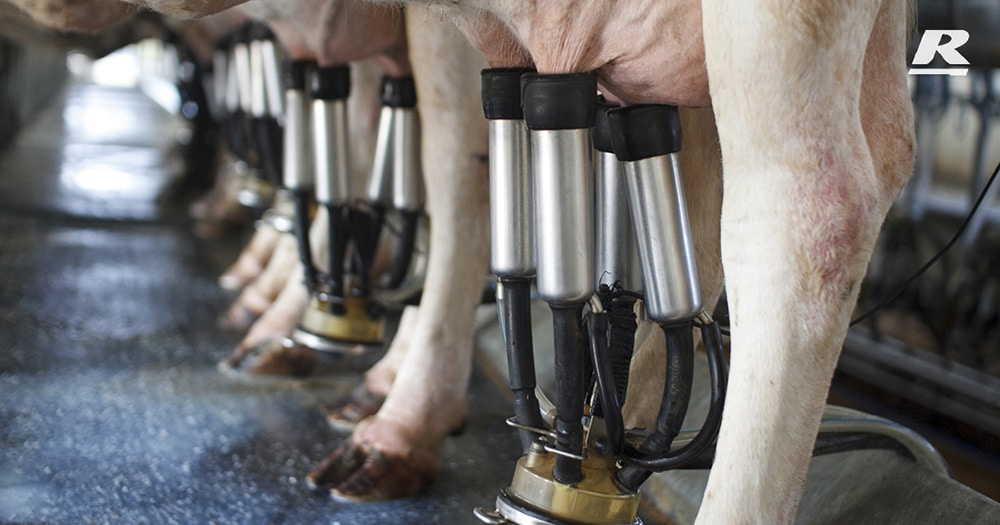Milk Fat Depression – Risk Factors and Solutions
Milk fat depression (MFD) is a common issue observed in Australian dairy cows. Highly fermentable and fatty acid rich pasture in winter-spring, coupled with altered rumen function, are risk factors for MFD.
Firstly, we need to distinguish between milk fat percentage and milk fat yield to determine if we have a “true” or perceived milk fat depression. Following a diet correction, at least 14 days are required to identify any changes in milk fat yield.
MFD is typically a multifaceted issue, and it is influenced by dry matter intake (DMI), diet balance and animal health. There are a number of nutritional and management strategies that can reduce the impact of MFD. The three risk factors are:
- High intake of polyunsaturated fatty acids (PUFAs)
- Fast rumen throughput
- Altered rumen function

High intake of PUFAs
Modern grass species can contain 6-8% fat in winter-spring; this high fat content is correlated with higher crude protein levels. Unsaturated fats in pastures must be detoxified by the rumen bugs and converted to saturated animal fat; this process is called biohydrogenation. When unsaturated fats in the diet are very high, the rumen bugs responsible for this conversion cannot keep up; some of this excess fat is converted to trans-10, cis-12 conjugated linoleic acids (trans-10 CLAs), which can interfere with milk fat synthesis in the mammary gland.
Fast rumen throughput
MFD is correlated with low rumen pH and fast rumen throughput. Lush pastures generally have lower fibre, as well as higher sugars, potassium (K) and soluble nitrogen (N). Physically effective fibre can slow down the rate of passage, increase rumen contractions and create a “rumen raft”. Rumen contractions and saliva production enhance the buffering capacity of the rumen, increase volatile fatty acid (VFA) transport across the rumen wall, and help to manage pH.
Altered rumen function
Optimising the rumen environment can be achieved by assessing the following:
- Effective Fibre – Introducing some hay or straw into the diet can encourage rumination and help to slow down rumen throughput.
- Pasture Management – Rotation length, leaf stage and fertilizer applications need to be managed appropriately so that pasture can be efficiently digested and utilised by the cow.
- Maize – Replacing some faster-fermenting wheat/barley/triticale with slower-fermenting dry corn can help to manage fluctuations in rumen pH.
- Yeasts & yeast by-products – May create a more stabilised rumen fermentation.
- Buffers – Such as sodium bicarbonate (bicarb) and AcidBuf can help stabilize rumen pH and promote a more ideal environment for the microbes to biohydrogenate the fat.
- Salt – Sodium is used for saliva (bicarb) production and osmolality of the rumen.
- Ionophores – Such as Monensin don’t cause MFD, but can interfere with the microbes responsible for fat biohydrogenation, amplifying a build-up of unsaturated fat in the rumen and a potential MFD issue. Ionophore inclusion in the diet needs to be weighed up against the benefits (bloat control).
- Non-forage fibre sources (NFFSs) – Such as almond meal and millrun can favour more acetate (precursor to milk fat).
Summary
Control and prevention of Milk Fat Depression needs to be approached holistically. Stage of lactation, body condition score, genetics, animal health status and farm management practices need to be considered. Diet balance and rumen pH can be influenced by the composition of the pellet/cattle grain ration, as well as pasture management. Following a diet correction, it can take 14 days to identify a change in milk fat synthesis. Your Reid Stockfeeds nutritionist will be able to identify these risk factors and provide tailored solutions for your farm.
Looking for a high carbohydrate grain supplement to feed your ewes during the last 6 weeks of pregnancy; why don’t you give us a call and have a chat to one of our nutritionist on 1300 REID FEED or enquire here >
 Author
Author
Chloe-Warden-Flood
Ruminant Nutritionist

 Author
Author